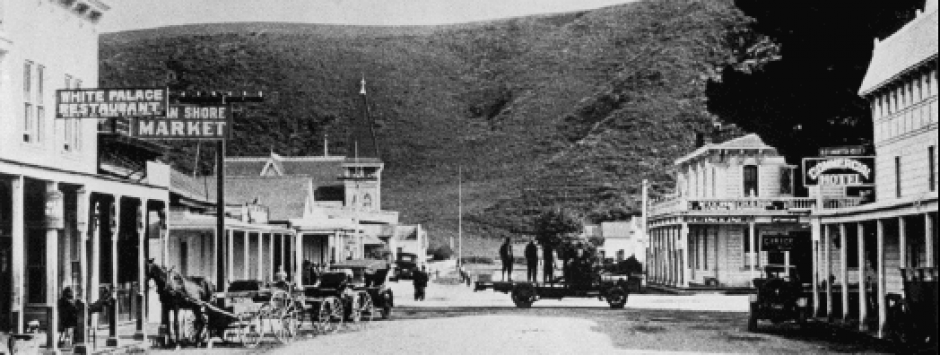and a second feeder to their big amusement center called “Pacific City” at Coyote Point. 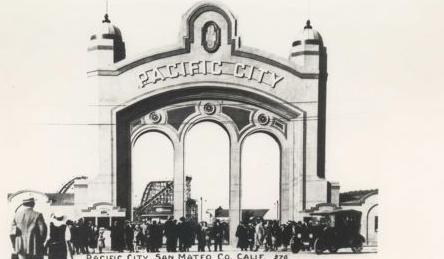
[Image above: Pacific City at Coyote Point was actually built. Here’s the entrance. perhaps on “opening day.” There were rides for the kids and a carnival atmosphere. Was this what railroad promoters had in mind for the Half Moon Bay area?]
[Image below: The fishing pier at Coyote Point, also known as “Pacific City.”
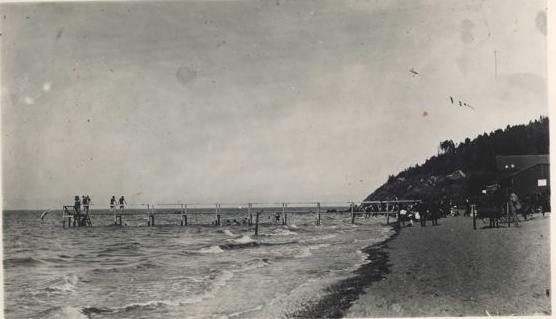
When passengers got off at the Southern Pacific railroad station in San Mateo, they would have had the choice of visiting Coyote Point or Half Moon Bay.
[Image below: You may have to turn this map on its side but it represents an early Ocean Shore Railroad route. Circa 1880s. Note that Half Moon Bay is called “Spanishtown, indicating that the locals were still calling the town by that name.]
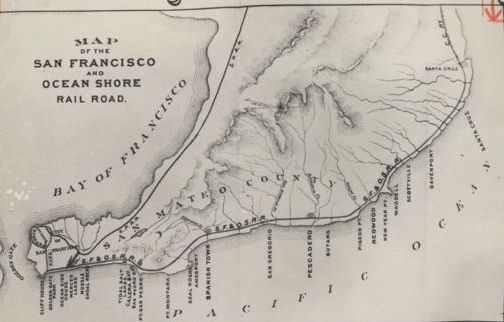
Story from John Vonderlin
Email John ([email protected])
The San Francisco Call
December 17, 1903
BEGIN WORK AT RAILROAD ENTERPRISE
Ground is Broken by the New Projectors of the Bowie and Clark Road Which is to Connect San Mateo With Coast Towns
FORCE OF LABORERS COMMENCE WORK
Large Quantities of Steel Rails, Ties, and Other Material Arrive and Are Being Distributed Along the Route
Special Dispatch to The Call
San Mateo-Dec. 16 Ground was broken yesterday for the new Bowie and Clark railroad, which is to connect the coast towns of Halfmoon Bay and Pescadero, on the west point, and Coyote Point on the bay. Large quantities of steel rails, crossties, and other materials have been arriving for several days, and all are now being distributed along the route.
Engineer E.F. Haas of San Francisco, who has charge of the construction, put a force of laborers to work on H Street yesterday, and the work of grading and laying the rail will be pushed forward vigorously. The route will be from the intersection of Third avenue and Railroad street, at the Southern Pacific crossing, down Third avenue to H street, through H to Poplar avenue, thence through that thoroughfare to Coyote Point. The franchise for this railroad was granted at recent meetings of the County Supervisors and City Trustees to Henry P. Bowie and Charles W. Clark. Under its term the road must be completed in the city limits within two years and in the county within five years. Just how much of it will be built now is not known. Clark is still in the East and Bowie is reticent about their plans.
Coyote Point is owned by the Bowie Estate, and the rumor is persistent that their present plans contemplate the extension of the road from Third avenue and Railroad street, to the point where a recreation resort, including baths, a hotel and other attractions will be erected to accommodate the large crowds of visitors that flock here during the summers.
It is given out unofficially that all of this is to be accomplished for the coming summer season. It is said as soon as Senator Clark recovers from his illness he will look into this enterprise with a view to taking an active and financial interest in it. In this event a more extensive line then is now contemplated may be expected to materialize. The tracks now being laid are for an electric road.
=================================
[Image below: A more accurate map of the route the Ocean Shore Railroad planned to take. “Planned to take” because the iron road deadended at Tunitas Creek, south of Half Moon Bay. Complicated engineering issues, the 1906 earthquake/fire, and, finally, bankruptcy drove the Ocean Shore out of business. According to the excellent book, “The Last Whistle,” by Jack Wagner (reprint! reprint!) the Ocean Shore wanted to turn the Coastside into a “Coney Island West,” as happened at Coyote Point.”
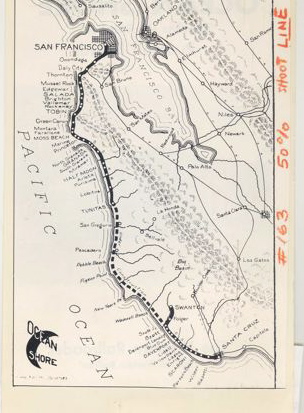
———————–
The Bowie name is mentioned in the article above. Here is an article about Henry Pike Bowie. Although it does not focus on the railroad and Pacific City, it does give you a flavor of the man.
Henry Pike Bowie
By June Morrall
[I wrote this in 1999]
In October, 1920, Henry Pike Bowie, a special emissary for the U.S. State Department, returned to his Hillsborough estate from Japan, the county he loved and honored.
The widower’s health was failing, and two months later the extraordinary 72-year-old recognized authority in all things Japanese, died in San Mateo County.
Upon Henry P. Bowie’s death, family members and close associates in California were startled to learn that the man they thought they knew so well had led a secret life encompassing the final decades of his life.
Born in the 1840s, Bowie relocated to the West Coast from Maryland with his physician father and siblings.
As a young man, Bowie vigorously pursued a legal career in San Francisco, studying law with a prominent attorney, Hall McAllister.
Another strong influence on Bowie was General G.H. L. Barnes. As senior counsel, General Barnes represented William Sharon in a scandalous case that rocked San Francisco and the Peninsula in 1884. In the crowded courtroom the contest pitted ex-U.S. Senator Sharon against a former mistress. The matter dragged on for many years, taking twists and turns, before finally being resolved after Sharon’s death.
Bowie entered the world of jurisprudence when he played a significant role in the fascinating “Pious Fund of California” litigation. This historic case dated back to the late 17th century when devout Spanish Catholics contributed $1 million for extending their religion through the missions they established in early California.
As California passed from Spanish rule into Mexican hands, the “Pious Fund” –little of which was used by the frugal Franciscans—disappeared about the time of the war with the U.S.
In the 1870s, more than two decades after California had been admitted into the union, San Francisco’s archbishop filed a claim seeking restitution of “Pious Fund” assets at the “Claims Convention” in Mexico. The archbishop prevailed, winning a substantial judgment, but it was difficult to collect, and there was follow-up litigation.
The case, argued by U.S. and Mexican attorneys in 1902, was the first heard by the International Court of Arbitration in The Hague in the Netherlands. The final judgment was rendered in favor of the U.S., and Mexico was ordered to pay about $1.5 million, in their legal currency, to the Catholic Church of California.
Although we do not know precisely what role Henry P. Bowie played in the “Pious Fund” litigation, his name was forever linked with the famous case.
Along the way, Bowie wed the twice-widowed Agnes Poett Howard in 1879. Bowie retired as an attorney, and the couple resided in Hillsborough, probably at her historic country estate, “El Cerrito,” the first of the great houses to dominate the Peninsula.
When Agnes died in 1893, Henry P. Bowie was said to have inherited the El Cerrito estate, and another property, including Coyote Point, two miles north of present day San Mateo, then isolated from the community by a long strip of marshland.
While the death of Agnes Poett Howard marked the end of a tender marriage, it was but the beginning of the last third of Henry P. Bowie’s iremarkable and secretive life.
In 1893, Bowie embarked on the first of six pilgrimages to Japan, where he resided with the Hirano family in Yokohama, near Tokyo.
The Hirano family –members of a closed society that did not easily embrace foreigners—made an unusual exception in Henry P. Bowie’s instance. This American fractured the barriers with his commitment to excel as a student in all things Japanese, and was thereby allowed to fully explore Japan’s art, literature, culture and religion.
Fluent in several European languages, Bowie learned Japanese, meeting and conversing with influential artists, who also became his intimate friends.
Bowie studied painting with Kuoboto Beisen, “the Michelangelo of Japan.” After perfecting the style, Bowie won awards for his pictures at public exhibitions, and the Japanese emperor reportedly acquired two of his paintings.
Bowie also satisfied his curiosity about “Shinto,” the indigenous Japanese religious tradition. He displayed a remarkable understanding of the fabled splendors of the sun goddess, “Amaterasu, the center of Shinto.
As part of Bowie’s education, he toured the countryside, admiring Japanese gardens and the simple gates marking the entrance to Shinto temples. But what struck him most was the beauty of an eight-pillared “Daimyo” gate, used chiefly by Japanese nobility at their country estates.
In the early 1900s, Bowie returned to San Mateo County from one of his many visits to Japan, and wrote a book called: “On the Laws of Japanese Painting.” And in the heart of “El Cerrito,” he created a “miniature Japan,” around his villa, “Severn Lodge,” which was in the old mission style with a red tile roof.
The landscaping merged the lawns, flowers and fountains he had seen in Versailles, France, with an avenue of Japanese cherry trees, gates, fences, ponds and bridges he had admired in the Land of the Rising Sun.
It was understandable that while Bowie resided at his HIllsborough estate, he often said his spirit remained in Japan.
An interesting aside reveals that at the same time Bowie was glorifying the people and the culture of Japan, Japanese suffered discrimination, separating them from Caucasians in schools, limiting citzenship and ownership of property. It was a predjudice not unlike that exhibited by the Japanese toward foreigners in their island homeland.
When anyone pressed Bowie for details on the events of his extraordinary new life, he changed the subject. It was easier to engage him in conversation in which he championed the Japanese cause on the eve of the Russo-Japanese war in 1904, a bitter struggle over which nation’s influence would prevail in Korea.
Japan would win the war, and to commemorate the victory, Bowie had his own eight-pillared Daimyo gate constructed by Japanese artisans at the entrance to his Hillsborough villa.
The gate took at least nine months to complete, beginning with a sketch by the eminent Japanese artist Shimada Sekko. This drawing was turned over to Suikichi Yagi, a young Japanese architect then residing in San Francisco, who translated it into a working plan.
Skillful carpenters, led by T. Hossoi, sailed from Osaka to Hillsborough where they prepared materials for construction of the memorial gate. The framework and pillars, made of eucalyptus wood, were treated to prevent them from splitting.
The roof, 35 feet in length, featured handmade redwood bark shingles, and the swinging doors, fashioned of eastern beechwood, weighed a ton each. The joinery work was dowled throughout throughout with no nails used.
When the gate was completed, the great Japanese writer of Chinese characters, Iwaya Ichi Roka, inscribed a heavy bronze plaque with words selected by Bowie: To The Glory And Grandeur of Japan.
As homage to the gardens of Japan, Bowie planted a double row of Japanese cherry trees on his property. Several Shinto gates, marking the entrance to Shinto temples in Japan, had already ben erected as well as Gengi fences, their panels etched with kami, divine beings represented by landscapes, birds, animals and fish.
Henry P. Bowie helped found the Japan Society of America, recruting Stanford University President David Starr Jordan as vice president of the cultural organization in 1907.
Two years later, Baron Shibusawa and other members of a distinguished commercial delegation lunched at the Burlingame Country Club before visiting Bowie’s villa. In a setting among the cherry trees, the special guests were served tea by Bowie’s Japanese servants. Much was discussed, but the highlight of the day was the official dedication of the Daimyo gate.
In October 1918 as World War I was ending. Bowie sailed to Japan for the sixth and final time as a special emissary of the U.S. Department of State.
During this official trip, the Japanese honored Bowie as a King of the Rising Sun, but in October, 1920 he felt ill, and with misgivings, returned to Severn Lodge in Hillsborough.
Two months later, the 72-year-old Henry Pike Bowie lay dead, and his secret life unraveled with the filing of his testament at the Redwood City courthouse.
It was a secret life most found impossible to believe.
Relatives were shocked to learn that one-half of the former scholar, linguist, painter, collector, and bon vivant’s estate, exclusive of specific bequests, was left to three Japanese friends who had never visited the United States: Komaka Hirano, and her two sons, Imao and Taweo.
Then came a second bombshell: Documents revealed that Komaka Hirano was the wife of Henry P. Bowie, and Imao and Taweo their sons.
This second blow stunned Bowie’s friends and especially his stepson, San Francisco architect George Henry Howard. But in Japan it was well known that Bowie was the head of a Japanese household in Yokohama. Notice of his death appeared prominently on the front page of Japanese newspapers.
Alleging that the Hiranos “exerted a baneful influence over Bowie,” George H. Howard contested the will in 1922. He contended Komaka Hirano was not his stepfather’s wife in the “accepted American meaning of the term”– but in a dramactic turn of events depositions signed by diplomats supported the marriage as authentic.
Howard also argued that “All my stepfather’s property was derived from my mother, who inheirted it from the Howard family–all hard-earned American dollars by California law, provided in our state code, it should revert to the descendants of the original possessors. It is a question of birthright, pure and simple.
But George H. Howard did not prevail as he neglected to serve a summons on the Japanese heirs and this technical failure led Redwood City Superior Judge George Buck to decline to set aside the will.
Henry P. Bowie, who treasured the peaceful flow of existence that Japan represented, left a maelstrom of discord in his own life.
When Henry P. Bowie was near death, he said he would have preferred being buried in the Land of the Rising Sun, but while his body was to be interred on American soil, his spirit would surely return to Japan.
—————–
[Note: Others have written about Henry P. Bowie. If you are interested, I encourage you to discover the stories by historians such as the popular professor/author Michael Svanevik.]
———————–
Charles Clark Had a Private Racetrack
What stunned first time visitors to Charles Walter Clark’s luxurious San Mateo estate El Palomar was “Clark’s Track,” a manicured private race track and polo field that graced the outstanding piece of property.
Charles Walter Clark was one of an unusual group of men who lived like European princes on the Peninsula one hundred years ago. Residing in spectacular country mansions, they surrounded themselves with paintings by the masters, priceless antiques and rare artifacts. Millionaire San Mateo sportsman “Charley” Clark may have owned his share of important paintings, but his reputation but his reputation was not built on works of art.
While Clark’s affluent neighbors invited friends to view their museum-quality galleries, Charley Clark arranged a day of horse racing for an intimate circle of rich friends. They preferred the thrill of thoroughbreds competing in a sumptuous setting.
Charles Clark was not a self-made man. His father, a U.S. senator from Montana, and a multi-millionaire copper mine owner, had everything to do with creating the image as well as the reality of his eldest son’s wealth.
In public, at every opportunity, the old senator bragged that his son had plenty of money. The younger Clark was described as the manager of his father’s United Verde Copper Company in Jerome, Arizona–an enterprise that earned the senator a reported $1 million per month.
Charles Clark was also said to be a partner with his father in a bank in Northern California. It was widely believed that from this joint venture the younger Clark drew $25,000 a month spending money.
And, if there was ever a need for extra cash, for any reason, at any time, Senator Clark was always there.
Charles Clark was was in his early 30s in 1904, a year that brought him unexpected sorrow. He was at the Arizona copper mine bad news arrived.. His wife, who resided at the family home in New York City, had fallen seriously ill and was clinging to life. The young man felt compelled to get to New York City, as soon as possible. As the privileged son of a U.S. senator, Clark pulled every string imaginable, arranging for a special chartered train to whisk him from the Southwest to New York. The train sped eastward, chewing up the miles of track in record time, but Clark waas too late. The newspapers of the day reported that his beloved wife passed away before the train arrived at its New York destination.
Clark’s heroic efort to reach his dying wife struck a sympathetic chord with the general public, and his desperate railroad race became part of popular legend. Now a widower, his bad luck continued and thorny problems began to plague the politician’s son.
Senator Clark always wanted folks to believe that his eldest son, Charles, was rich and successful. There was little reason to doubt this was true. So, there was great surprise when Clark became mired in negotations with the Rosario Mining Company in Mexico and was subsequently accused of breach of contract.
He was expected to take possession of the mine and begin exploration but he did neither. The angry officials at Rosario filed a lawsuit, and at one point the case seemed to have been on the verge of dismissal. Still, observers were surprised and concerned about Clark’s actions in the matter.
Another puzzling incident occurred about the same time. At an extravagant dinner at Rector’s in New York City, Clark ordered vintage wines and lobsters for the assembled guests, then walked out, leaving the bill unpaid. Sued by the restaurant owner, the matter was actually settled two years later.
It was still 1904 when Clark acquired El Palomar in San Mateo, an estate formerly owned by a well known polo player. What he did with El Palomar enhanced Clark’s reputation and brought notoriety to San Mateo.
Widower Clark, who had many friends, spent a lot of time in San Francisco. It was “in the City” that he met and fell in love with society leader Cecila Tobin***, a fine and proper lady whose distinguished family had founded the Hibernia Bank.
Celia Tobin’s varied talents and interests were very appealing to Charles Clark. A gifted musician, the sportswoman was more widely admired for her expert horsemanship. This shared love of horses bonded the who planned a simple but elegant wedding in the house where Celia was born. This shared love of horses bonded the pair, and they planned a simple but elegant wedding in the house where Ceiia was born.
From all accounts the wedding was perfect. The bridal party gathered in a rose-decorated parlor before the famous copy of Murillo’s masterpiece: the Madonna from the Prado Gallery in Madrid.
Carrying a stunning bouquet of orchids, Ceilia wore an elaborately trimmed robe-dress, a gift from her mother. A sparkling diamond-and-turquoise ring from her sister, Agnes, the maid of honor, adorned the bride’s finger. Other gifts from the Tobin family included a spectacular diamond crescent and diamond cross.
Archbishop Montgomery presided over the ceremony that united Charles Clark and Celia Tobin.
Lending a special excitement to the event was the appearance of legendary stage actress Ethel Barrymore, who had been visiting one of Ceilia’s relatives.
After the traditional wedding breakfast, the newlyweds left San Francisco in a special train bound for San Mateo. But when the couple arrived at El Palomar, they were shocked to see a legal document the County sheriff had tacked to the front door.
On the previous day the Bank of California had filed an attachment suit against Charles Clark, who, it seemed, had not repaid two loans for $25,000 each. Further complicating the matter was the unexpected revelation that it was the sportsman’s father, not Charles, who held title to El Palomar. This led to great embarassment, and Clark immediately issued a statement assuring bank officials he would sort out the matter at once–and he did.
With that “misunderstanding” out of the way, the Clarks enjoyed the early years of their marriage. They frequently traveled to the Rocky Mountains where it was said Celia shot grizzly bears, elk and mountain lions. On these occasions Clark chartered a private railway car fo rhis wife’s use.
When they weren’t traveling, they invited society figures to the private racetrack at El Palomar. But on occasion the Clarks opened the gates to the public.
For example, in 1907, the Irish-American Athletic Club sponsored track-and-field events at El Palomar consisting of a mile run, 300=yard race, 220 hurdles, shot and discus throw. Celia Clark presented the winners with impressive trophies specially designed for the games.
To outsiders the Clark’s life appeared idyllic until the “Rosario Mining” court case, at first a pleasant distraction, turned into an argument-starter every time they tried to do something together.
The Rosario officials wanted compensation for the breach of contract committed before Clark’s marriage to Celia. In 1907 their legal strategy consisted of charging Clark with insolvency so that the court would order United Verde Copper Company’s books opened to determine whether Clark was indeed the general manager and the owner of controlling stock in the operation.
Eventually the irritating Rosario case was settled in which the court ordered Clark to compensate the Mexican mining company.
All the while Clark had been plagued with the Rosario matter, he never allowed it to interfere with his generosity and extravagant lifestyle. During the 1907 Christmas holiday , the Clarks hosted a fabulous dinner for Burlingame friends at San Francisco’s Fairmont Hotel
Reporting on the event, the press indicated that a rare 1889 champagne was served to guests who dined on solid gold dinner plates requiring the presence of private detectives in the beautiful room.
By 1912, Clark, the president of the Golden Gate Thoroughbred Breeders Association, had earned a reputation as one of the most active patrons of “the sport of kings” in California.
Racing under his own popular colors, the El Palomar stable consisted of well known champions of the time such as Rose Marion, Pleasureville, Birdie, Gun Powder, and, of course, the aptly named El Palomar.
Clark’s horses were superbly trained, sleek and fast, winning stakes and honors at race venues all over the country.
Although it was well known to those close to him that Charles W. Clark didn’t handle business matters well, when it came to his polo interests, he was indefatigable.
In 1913, a San Mateo polo team, the Slashers, was scheduled to play a cavalry team from Hawaii at “Clark’s Track.” The Peninsula team featured skilled players including W. B. Devereux, a pioneer mining engineer. But the team was short one polo pony. Charley Clark immediately purchased “Big Jim,” a crack polo pony, for $2000., and had the animal shipped by a specially chartered train to El Palomar. With “Big Jim,” the San Mateo team won the game.
It was about this time that horse racing had been banned in California, and Clark favored its revival under the pari-mutuel betting system.
In a letter to officials, he urged formation of a state racing commission and was prophetic in describing the future for thoroughbred racing in California and the entire nation.
“Racing has been revived recently at several places in the East under the pari-mutuel system of wagering,” Clark wrote. “As you know, this is the French system of betting, and in France the government had charge of the meetings and clean sport was witnessed. The machine betting does away with the bookmakers and eliminates the chance for crookedness.”
Although there was no longer racing at El Palomar, it became a noted stock farm for California-bred horses.
As the years passed, relations between Ceiia and Charles first became distant and then strained. They quietly separated, divorced, and he remarried.
At the time of Charles W. Clark’s death during the Great Depression, in 1933, he was the president of the United Verde Copper Company.
Two years earlier Ceilia Tobin Clark commissioned architect David Adler to build for her the famous 36-room mansion–called the “House on the Hill”–in an oak-studded setting not far from El Palomar.
Until her death in 1965, art patron and philanthropist Celia Tobin Clark remained a powerful figure in the social and cultural life of the San Francisco Bay Area.
————–
***Celia Tobin Clark commissioned the architect David Adler to build her beautiful home in Hillsborough after she divorced Charles Clark. Ms. Tobin’s family had founded the Hibernia Bank in San Francisco. Construction began during the Depression and care was taken to hire many local workers. Photos and drawings of her home can be seen in a book of David Adler’s work called “David Adler, Architect: The Elements of Style.”
